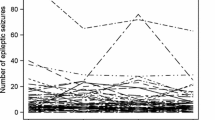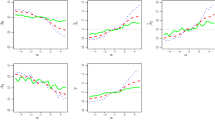Abstract
A critical issue in modeling binary response data is the choice of the links. We introduce a new link based on the Student’s t-distribution (t-link) for correlated binary data. The t-link relates to the common probit-normal link adding one additional parameter which controls the heaviness of the tails of the link. We propose an interesting EM algorithm for computing the maximum likelihood for generalized linear mixed t-link models for correlated binary data. In contrast with recent developments (Tan et al. in J. Stat. Comput. Simul. 77:929–943, 2007; Meza et al. in Comput. Stat. Data Anal. 53:1350–1360, 2009), this algorithm uses closed-form expressions at the E-step, as opposed to Monte Carlo simulation. Our proposed algorithm relies on available formulas for the mean and variance of a truncated multivariate t-distribution. To illustrate the new method, a real data set on respiratory infection in children and a simulation study are presented.




Similar content being viewed by others
References
Albert, J., Chib, S.: Bayesian analysis of binary and polychotomous response data. J. Am. Stat. Assoc. 88, 669–679 (1993)
Breslow, N., Clayton, D.: Approximate inference in generalized linear mixed models. J. Am. Stat. Assoc. 88, 9–25 (1993)
Chib, S., Greenberg, E.: Analysis of multivariate probit models. Biometrika 85, 347–361 (1998)
Czado, C., Santner, T.: The effect of link misspecification on binary regression inference. J. Stat. Plan. Inference 33, 213–231 (1992)
Delyon, B., Lavielle, M., Moulines, E.: Convergence of a stochastic approximation version of the EM algorithm. Ann. Stat. 27, 94–128 (1999)
Fernandez, C., Steel, M.F.: Multivariate student-t regression models: pitfalls and inference. Biometrika 86, 153–167 (1999)
Genz, A., Bretz, F., Hothorn, T., Miwa, T., Mi, X., Leisch, F., Scheipl, F.: mvtnorm: multivariate normal and t distribution. R package version 0.9-2 (2008). http://CRAN.R-project.org/package=mvtnorm
Ho, H.J., Lin, T.I., Chen, H.Y., Wang, W.L.: Some results on the truncated multivariate t distribution. J. Stat. Plan. Inference 142, 25–40 (2012)
Højsgaard, S., Halekoh, U., Yan, J.: The R package geepack for generalized estimating equations. J. Stat. Softw. 15, 1–11 (2005)
Jamshidian, M.: Adaptive robust regression by using a nonlinear regression program. J. Stat. Softw. 4, 1–25 (1999)
Johnson, S., Narasimhan, B.: Package cubature. R package version 1.1-1 (2011). http://cran.r-project.org/web/packages/cubature/index.html
Lachos, V.H., Angolini, T., Abanto-Valle, C.A.: On estimation and local influence analysis for measurement errors models under heavy-tailed distributions. Stat. Pap. 52, 567–590 (2011)
Lange, K.L., Sinsheimer, J.S.: Normal/independent distributions and their applications in robust regression. J. Comput. Graph. Stat. 2, 175–198 (1993)
Lee, Y., Nelder, J.: Double hierarchical generalized linear models. Appl. Stat. 55, 139–185 (2006)
Lin, T.I., Lee, J.C.: Estimation and prediction in linear mixed models with skew-normal random effects for longitudinal data. Stat. Med. 27, 1490–1507 (2008)
Liu, C.: Robit regression: a simple robust alternative to logistic and probit regression. Applied Bayesian modeling and causal inference from incomplete-data perspectives, pp. 227–238 (2004)
Lucas, A.: Robustness of the student t based M-estimator. Commun. Stat., Theory Methods 26, 1165–1182 (1997)
Matos, L.A., Prates, M.O., H-Chen, M., Lachos, V.: Likelihood-based inference for mixed-effects models with censored response using the multivariate-t distribution. Stat. Sin. 23, 1323–1342 (2013)
McCulloch, C.: Maximum likelihood variance components estimation for binary data. J. Am. Stat. Assoc. 89, 330–335 (1994)
McCulloch, C.E.: Maximum likelihood algorithms for generalized linear mixed models. J. Am. Stat. Assoc. 92, 162–170 (1997)
McLachlan, G., Krishnan, T.: The EM Algorithm and Extensions. Wiley, New York (1997)
Meng, X., van Dyk, D.: Fast EM-type implementations for mixed effects models. J. R. Stat. Soc. B 60, 559–578 (1998)
Meza, C., Jaffrézic, F., Foulley, J.: Estimation in the probit normal model for binary outcomes using the SAEM algorithm. Comput. Stat. Data Anal. 53, 1350–1360 (2009)
Pinheiro, J.C., Liu, C.H., Wu, Y.N.: Efficient algorithms for robust estimation in linear mixed-effects models using a multivariate t-distribution. J. Comput. Graph. Stat. 10, 249–276 (2001)
R Core Team: R: A Language and Environment for Statistical Computing. R Foundation for Statistical Computing, Vienna (2013). http://www.R-project.org
Robert, C., Casella, G., Robert, C.: Monte Carlo Statistical Methods vol. 2. Springer, New York (1999)
Tan, M., Tian, G., Fang, H.: An efficient MCEM algorithm for fitting generalized linear mixed models for correlated binary data. J. Stat. Comput. Simul. 77, 929–943 (2007)
Acknowledgements
We thank the editor, associate editor and two referees, whose constructive comments led to a much improved presentation. Victor Lachos acknowledges support from CNPq-Brazil (Grant 305054/2011-2) and from FAPESP-Brazil (Grant 2011/17400-6). Marcos Prates would like to acknowledge the partial support of Fundação de Amparo à Pesquisa do Estado de Minas Gerais (FAPEMIG-Brazil).
Author information
Authors and Affiliations
Corresponding author
Appendix
Appendix
Proof of Proposition 1
First note that if X∼t p (μ,Σ,ν), then we can write
It follows that
which concludes the proof. □
Lemma 1
If U∼Gamma(α,β), then for any vector \(\mathbf{B}\in \mathbb{R}^{p}\) and a p×p positive definite matrix Σ,
Proof
If V∼N p (0,Σ); then
where, clearly \(\mathbf{T}=\frac{\mathbf{V}}{(U\beta/\alpha)^{1/2}}\) has a multivariate Student’s t-distribution, which concludes the proof. □
Details of the EM Algorithm:
Treat \(\mathbf{b}=\{\mathbf{b}_{i}\}^{m}_{i=1}\), \(\mathbf{Z}=\{\mathbf{Z}_{i}\}^{m}_{i=1}\) and \(\mathbf{U}=\{{U}_{i}\}^{m}_{i=1}\) as missing data. From the definition of the latent variable Z, we have {Y,Z}=Z. Then, the joint density for the complete-data Y com ={Y,Z,b,U} is
To complete the demonstration about how to employ the EM-type algorithm for ML estimation of the t-GLMM, it is necessary to derive the four conditional expectations of the complete-data sufficient statistics: E[U i |Y i ], E[U i Z i |Y i ], E[U i b i |Y i ] and \(E[U_{i}\mathbf {b}_{i}\mathbf {b}^{\top}_{i}|\mathbf {Y}_{i}]\). To calculate them, we first derive the conditional predictive distribution of the missing data, which is given by:
Since f(b|Y,Z,u,θ) is proportional to (9), we obtain the following result:
where \(\boldsymbol {\varDelta }_{i}=\mathbf {D}\mathbf {W}^{\top}_{i} \boldsymbol {\varOmega }_{i}^{-1}\), \(\boldsymbol {\varLambda }_{i}=\mathbf {D}-\mathbf {D}\mathbf {W}^{\top}_{i}\boldsymbol {\varOmega }^{-1}_{i}\mathbf {W}_{i}\mathbf {D}\) and \(\boldsymbol {\varOmega }_{i}=\mathbf {W}_{i}\mathbf {D}\mathbf {W}^{\top}_{i}+\mathbf{I}_{n_{i}}\), i=1,…,m. To derive the second term on the right-hand side of (10), we use the following result from Chib and Greenberg (1998)
which indicates that given Z i , the conditional probability of Y i is independent of b i and u i . Hence, expression (11) implies \(P(\mathbf {Y}_{i}=\mathbf {y}_{i}|\mathbf {Z}_{i},\boldsymbol {\theta })=\mathbb{I}_{(\mathbf {Z}_{i} \in \mathbb{B}_{i})}\). Since the conditional probability Z i |u i ,θ is normally distributed and U i ∼Gamma(v/2,v/2), the marginal distribution of Z i |θ follows \(t_{n_{i}}(\mathbf {X}_{i}\boldsymbol {\beta },\boldsymbol {\varOmega }_{i},\nu)\). Furthermore, from
we obtain
Using the prior results and the property that, if Z|θ follows t p (μ,Σ,ν) and U∼Gamma(ν/2,ν/2), we have \(E[U|\mathbf {Z}]=\frac{\nu+p}{\nu+\delta}\) (Lachos et al. 2011), where δ represents the Mahalanobis distance. It follows that:
where \(\bar{\mathbf {Z}}^{2}_{i}=E [\frac{\nu+n_{i}}{\nu+\delta_{i}}\mathbf {Z}_{i}\mathbf {Z}^{\top}_{i}|\mathbf {Y}_{i} ]\), \(\delta_{i}=(\mathbf {Z}_{i}-\boldsymbol {\gamma }_{i})^{\top} \boldsymbol {\varOmega }^{-1}_{i}(\mathbf {Z}_{i}-\boldsymbol {\gamma }_{i})\), \(\boldsymbol {\varDelta }_{i}=\mathbf {D}\mathbf {W}^{\top}_{i} \boldsymbol {\varOmega }_{i}^{-1}\), \(\boldsymbol {\varLambda }_{i}=\mathbf {D}-\mathbf {D}\mathbf {W}^{\top}_{i}\boldsymbol {\varOmega }^{-1}_{i}\mathbf {W}_{i}\mathbf {D}\), \(\boldsymbol {\varOmega }_{i}=\mathbf {W}_{i}\mathbf {D}\mathbf {W}^{\top}_{i}+\mathbf{I}_{n_{i}}\), γ i =X i β, and \(\mathbb{B}_{i}=B_{i1}\times\cdots\times B_{in_{i}}\), where B ij is the interval (0,∞) if y ij =1 and the interval (−∞,0] if y ij =0.
Rights and permissions
About this article
Cite this article
Prates, M.O., Costa, D.R. & Lachos, V.H. Generalized linear mixed models for correlated binary data with t-link. Stat Comput 24, 1111–1123 (2014). https://doi.org/10.1007/s11222-013-9423-3
Received:
Accepted:
Published:
Issue Date:
DOI: https://doi.org/10.1007/s11222-013-9423-3




